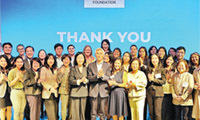Scientists Raise Questions About Genetic Risks and IVF

Abnormal patterns of gene expression may be tied to in vitro fertili zation. / SANDY HUFFAKER/GETTY IMAGES
By GINA KOLATAOver the past 30 years, in vitro fertilization has been reassuringly safe. Millions of healthy children have been born and developed normally. And the first IVF baby, Louise Brown, born in England on July 25, 1978, now has her own child, conceived without the technique.
But researchers have always wondered whether there might be subtle changes in an embryo that is grown for several days in a petri dish, as IVF embryos are - and, if so, whether would there be any consequences.
Now, with new epidemiological studies and techniques that allow scientists to probe the genes of embryo cells, some tentative answers are starting to emerge.
The issues have nothing to do with the chances that a woman will have twins, triplets or even, as just happened in California, octuplets. Instead, they involve questions of whether there are changes in gene expression or in developmental patterns.
For example, some studies indicate that there may be some abnormal patterns of gene expression associated with IVF and a possible increase in rare but devastating genetic disorders that appear to be directly linked to those unusual gene expression patterns. There also appears to be an increased risk of premature birth and of babies with low birth weight.
In November, the Centers for Disease Control and Prevention published a paper reporting that babies conceived with IVF, or with a technique in which sperm are injected into eggs, have a slightly increased risk of several birth defects, including a hole between the two chambers of the heart, a cleft lip or palate and an improperly developed esophagus.
The study involved 9,584 babies with birth defects and 4,792 babies without. Among the mothers of babies without birth defects, 1.1 percent had used IVF or related methods, compared with 2.4 percent of mothers of babies with birth defects.
The findings are considered preliminary, and researchers say they believe IVF does not carry excessive risks. There is a 3 percent chance that any given baby will have a birth defect.
But the real question - what is the chance that an IVF baby will have a birth defect? - has not been definitively answered. The C.D.C. study provides comparative risks but not absolute risks.
Yet even though the risks appear to be small, researchers who are studying the molecular biology of embryos grown in petri dishes say they would like a better understanding of what happens.
But following babies born after IVF or intracytoplasmic sperm injection is not easy. And if problems emerge from epigenetic changes, they may not be apparent until adulthood.
“When you send questionnaires, the tendency is for the couple who may have had a problem or who think they have a problem to answer that questionnaire,”said Dr.Zev Rosenwaks, director of the Center for Reproductive Medicine and Infertility at New York Weill Cornell Center.
Those who do not respond tend to be parents whose children seem fine, skewing the data.
스마터리빙
more [ 건강]
[ 건강]이제 혈관 건강도 챙기자!
[현대해운]우리 눈에 보이지 않기 때문에 혈관 건강을 챙기는 것은 결코 쉽지 않은데요. 여러분은 혈관 건강을 유지하기 위해 어떤 노력을 하시나요?
 [ 건강]
[ 건강]내 몸이 건강해지는 과일궁합
 [ 라이프]
[ 라이프]벌레야 물럿거라! 천연 해충제 만들기
 [ 건강]
[ 건강]혈압 낮추는데 좋은 식품
[현대해운]혈관 건강은 주로 노화가 진행되면서 지켜야 할 문제라고 인식되어 왔습니다. 최근 생활 패턴과 식생활의 변화로 혈관의 노화 진행이 빨라지고
사람·사람들
more
[인터뷰] “미국 최고의 중학생으로 교육할 것”
LA 한인타운 내 최초의 한인 운영 수학·과학 중학교인 ‘윈저 아카데미’(WMSA, 4055 Wilshire Blvd. #400, LA)가 지…

KAF, 23개 비영리단체에 22만여불 지원
LA에 본부를 둔 커뮤니티 재단 KAF(Korean American Foundation·이사장 존 임)가 지난 5일 EK 갤러리에서 ‘2025…
“1세대 부모님 잘 케어하기”
한인 1세대 부모를 모시고 2세대 자녀를 키우고 있는 이른바 ‘샌드위치 세대’ 한인들을 위해 노부모를 잘 케어하기 위한 각종 정보를 총망라해 …
“이념 넘어 상호 존중, 한반도 평화의 기반”
장병우 LA 평통 신임회장이 평통의 역할을 강조하고 있다. [박상혁 기자]“이념보다 중요한 건 상호 존중입니다. 서로를 인정하는 데서 한반도 …
센터메디컬그룹 제4회 ‘이웃섬김’ 시니어 골프대회…
센터메디컬그룹(Center IPA)이 주최한 제4회‘이웃섬김’ 시니어 골프대회가 지난 3일 부에나팍의 로스 코요테스 컨트리클럽에서 130여 명…
많이 본 기사
- 푸드스탬프(SNAP) 가주 전액 지급에 재무부 “취소하라”
- 또 수천편 결항·지연… 연결편 취소 한인들 ‘발동동’
- 한인 주점서 총격 참극… 2명 사망·2명 부상
- 40일째 셧다운 사태 급반전…민주 중도파 돌아서며 종결 국면
- 임영웅, 콘서트 끝내고..축구화에 빠졌네
- “당뇨병·비만 등 질병 있으면 비자 거부”
- 한인 변호사 190여명 새로 탄생
- 백지연, 300만 원 레이저 시술 후회 “좋은 크림이나 살걸”
- 이찬원 “50대 밑으로는 여자로 안 보여..3040은 아기”
- ‘이다인♥’ 이승기, 확 변한 비주얼
- 로제·케데헌 그래미 후보에 K팝 ‘올해의 노래’ 첫 도전
- “내년부터 소셜연금 받기 더 까다로워진다”
- “전국민 1인당 최소 2,000달러 배당금 지급”
- 스타 유튜브 줄줄이 털렸다..손연재·김성은 이어 한혜진도 충격
- 안면 인식으로 불체자 색출 단속한다
- 트럼프-맘다니 대리전?… 내년 뉴욕주지사 선거 ‘재결투’
- 주소 잘못 찾아갔다가 집주인 총격에 사망
- 한인타운 등 LA 대규모 정전사태
- 내일 베테런스데이… 관공서·은행·우체국 등 휴무
- “안 팔리면 안 팔아요”… 집값 올리는 ‘디리스팅’
- 테슬라 FSD, “내 목숨 구했다” vs “낭떠러지로 달렸다”
- 췌장암 신약, 종양 64% 줄였다… 새로운 희망 되나
- ‘모든 것이 결국은 중국’이라고…
- 지식 아키텍트?… 인공지능이 만들어 낸 신종 직무
- [캐슬린 파커 칼럼] 워싱턴의 멍청한 ‘헝거 게임’
- 지붕은 날아가고, 차는 깔리고… 토네이도의 위력
- [업계 화제] “김스전기 카탈로그… 마흔살 됐어요”
- [만화경] ‘재정 침체’ 징후 보이는 프랑스
- 초등학교에서 중학교로… 우리 아이 도울 방법 없을까?
- 셧다운 혼란↑…각州 “저소득층지원금 집행” 재무부 “돈못줘”
- [허두영의 해적경영학] 신화의 무게를 감당하라 : 잭 래컴 & 애덤 노이먼
- ‘메시 2골 1도움’인터 마이애미 내슈빌 꺾고 MLS PO 8강 진출
- 화이자, 세기의 비만약 인수전 승리
- “재외공관장 40% 비외교관으로”… LA도 ‘특임’ 오나
- 낙태권 이어 동성결혼 합법화 뒤집나
- 윤이나, 올 시즌 첫 LPGA 투어 톱10…토토 재팬 클래식 4R 취소
- 주택시장지수 6개월래 최고… 금리인하 기대
- AI(인공지능)발 ‘고용절벽’ 본격… 연준 금리인하 힘 실리나
- [이민법 칼럼] 노동카드 연장 신청 빨리 해야
- 삼성전자·바클레이스 미 신용카드 출시 추진
- 웸반야마 18점 18리바운드… 샌안토니오, 2위 도약
- 제52회 LA 한인축제 사진전 개막
- 나를 기억하는 교사의 말이 입시 결과 바꾼다
- 불체자 구금환경 개선명령 연방 법원 “위헌적 상황”
- 삼성 SDI, BMW와 ‘꿈의배터리’ 실증 나선다
- 풋볼 시즌 2025
- 첫 학교 경험 ‘유치원’ 진학… 부모가 이렇게 도와주세요
- “밀리면 끝” 구글도 빚투… 빅테크, 3조달러 쏜다
- 포스코, 미국 2위 철강사 지분 투자로 현지 생산
- 연말샤핑 매출, 첫 1조달러 돌파
1/5지식톡

-
 테슬라 자동차 시트커버 장착
0
테슬라 자동차 시트커버 장착
0테슬라 시트커버, 사놓고 아직 못 씌우셨죠?장착이 생각보다 쉽지 않습니다.20년 경력 전문가에게 맡기세요 — 깔끔하고 딱 맞게 장착해드립니다!장착비용:앞좌석: $40뒷좌석: $60앞·뒷좌석 …
-
 식당용 부탄가스
0
식당용 부탄가스
0식당용 부탄가스 홀세일 합니다 로스앤젤레스 다운타운 픽업 가능 안녕 하세요?강아지 & 고양이 모든 애완동물 / 반려동물 식품 & 모든 애완동물/반려동물 관련 제품들 전문적으로 홀세일/취급하는 회사 입니다 100% …
-
 ACSL 국제 컴퓨터 과학 대회, …
0
ACSL 국제 컴퓨터 과학 대회, …
0웹사이트 : www.eduspot.co.kr 카카오톡 상담하기 : https://pf.kakao.com/_BEQWxb블로그 : https://blog.naver.com/eduspotmain안녕하세요, 에듀스팟입니다…
-
 바디프렌드 안마의자 창고 리퍼브 세…
0
바디프렌드 안마의자 창고 리퍼브 세…
0거의 새제품급 리퍼브 안마의자 대방출 한다고 합니다!8월 23일(토)…24일(일) 단 이틀!특가 판매가Famille: $500 ~ $1,000Falcon: $1,500 ~ $2,500픽업 & 배송직접 픽업 가능LA…
-
 바디프렌드 안마의자 창고 리퍼브 세…
0
바디프렌드 안마의자 창고 리퍼브 세…
0거의 새제품급 리퍼브 안마의자 대방출 한다고 합니다!8월 23일(토)…24일(일) 단 이틀!특가 판매가Famille: $500 ~ $1,000Falcon: $1,500 ~ $2,500픽업 & 배송직접 픽업 가능LA…
케이타운 1번가
오피니언
 옥세철 논설위원
옥세철 논설위원‘모든 것이 결국은 중국’이라고…
 캐슬린 파커 워싱턴포스트 칼럼니스트
캐슬린 파커 워싱턴포스트 칼럼니스트 [캐슬린 파커 칼럼] 워싱턴의 멍청한 ‘헝거 게임’
 허두영 한국과학언론인회 회장
허두영 한국과학언론인회 회장 [허두영의 해적경영학] 신화의 무게를 감당하라 : 잭 래컴 & 애덤 노이먼
 전지은 수필가
전지은 수필가 풋볼 시즌 2025
 최형욱 / 서울경제 논설위원
최형욱 / 서울경제 논설위원[만화경] ‘재정 침체’ 징후 보이는 프랑스

11·4 선거에 드러난 민심 직시해야

‘얌체’ 관행 끊고 평통의 품격 세워야
 조지 F·윌 워싱턴포스트 칼럼니스트
조지 F·윌 워싱턴포스트 칼럼니스트 [조지 F. 윌 칼럼] 빌 게이츠의 ‘기후 변화’에 대한 입장 변화
 손영아 문화 칼럼니스트·YASMA7 대표
손영아 문화 칼럼니스트·YASMA7 대표 [한국춘추] 펄먼 할아버지의 80년 인생 이야기
1/3지사별 뉴스

‘30대 사회주의자' 맘다니, 최초 무슬림 뉴욕시장 당선
초미의 관심을 모았던 뉴욕시장 본선거에서 조란 맘다니 민주당 후보가 승리하면서 역대 최초의 무슬림 뉴욕시장이 탄생했다. 초박빙 판세로 여겨졌던…
‘출구 못찾는’ 정부 셧다운…‘역대최장’ 36일 신기록

한국학교협 분쟁, 법원 선택은
메릴랜드 하워드카운티 순회법원이 5일 미 전역의 1,000여개 한글학교를 대표하는 뿌리교육 단체인 재미한국학교협의회(The National A…
구순 노인의 빛나는 역사 노익장

워싱턴DC 풋볼팀 새 구장 이름에 트럼프?… “본인이 원해”
도널드 트럼프 대통령이 워싱턴DC에 지어질 미국프로풋볼(NFL) 팀 워싱턴 커맨더스의 새 구장에 본인 이름을 넣기를 희망하고 있다고 스포츠 전…
봉사회 기금 모금 골프대회

오늘 하루 이 창 열지 않음 닫기 


















































.png)


댓글 안에 당신의 성숙함도 담아 주세요.
'오늘의 한마디'는 기사에 대하여 자신의 생각을 말하고 남의 생각을 들으며 서로 다양한 의견을 나누는 공간입니다. 그러나 간혹 불건전한 내용을 올리시는 분들이 계셔서 건전한 인터넷문화 정착을 위해 아래와 같은 운영원칙을 적용합니다.
자체 모니터링을 통해 아래에 해당하는 내용이 포함된 댓글이 발견되면 예고없이 삭제 조치를 하겠습니다.
불건전한 댓글을 올리거나, 이름에 비속어 및 상대방의 불쾌감을 주는 단어를 사용, 유명인 또는 특정 일반인을 사칭하는 경우 이용에 대한 차단 제재를 받을 수 있습니다. 차단될 경우, 일주일간 댓글을 달수 없게 됩니다.
명예훼손, 개인정보 유출, 욕설 등 법률에 위반되는 댓글은 관계 법령에 의거 민형사상 처벌을 받을 수 있으니 이용에 주의를 부탁드립니다.
Close
x